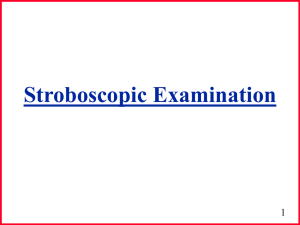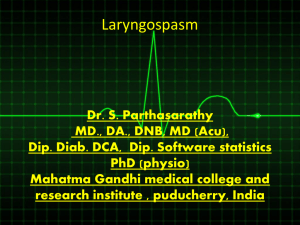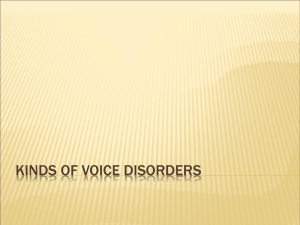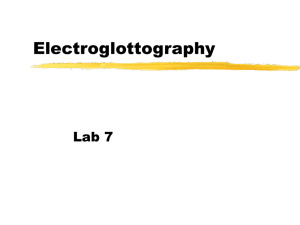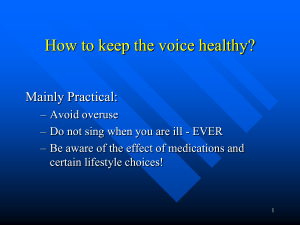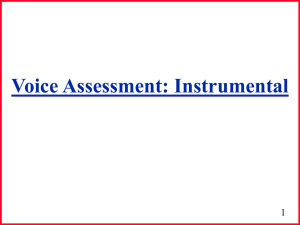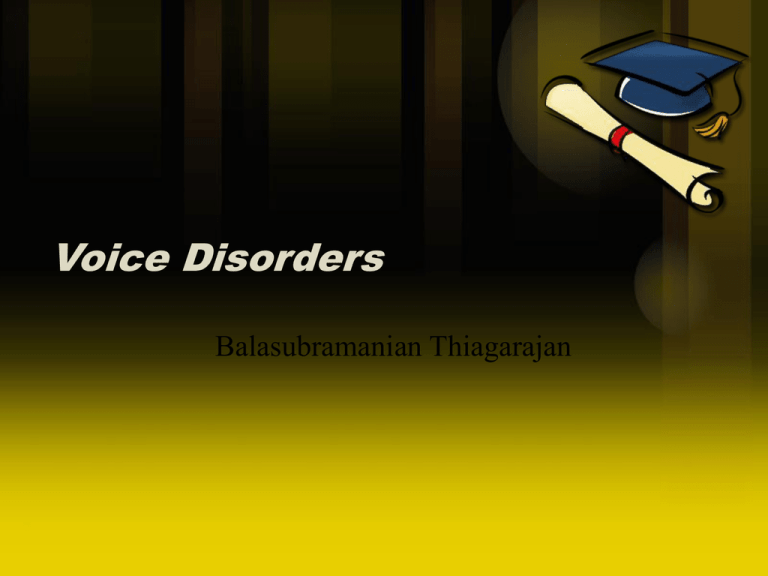
Voice Disorders
Balasubramanian Thiagarajan
Introduction
• Normal voice is difficult to interpret
• Voice disorders should be classifiable
• Voice disorders should be objectively
quantifiable
Normal voice - Pre-requisites
•
•
•
•
•
•
Normal range of vocal fold mobility
Normal mobility of mucosa on deep layers
Optimal co-aptation of vocal fold edges
Optimal motor force at glottic closure
Optimal pulmonary support
Optimal timing of the glottic closure in
relation to the onset of phonatory expiration
• Optimal tuning of vocal fold tension
Phonatory expiration
• This occurs when the person
is attempting to speak
• Vocal folds on both sides
approximate along their
entire antero-posterior
dimension
• This can be tested by asking
the patient to say (eeee)
while performing
laryngoscopic examination
• In non phonatory expiration
vocal folds are gently
abducted
Non phonatory expiration
Glottal cycle
• Opening phase
• Closing phase
• Closed phase
Opening phase
• Vocal fold gets blown upwards by increasing
subglottic pressure
• Undulating wave moves on the medial margin
from the lower part to upper part.
Closing phase
• After the width of the glottis reaches the
maximum, subglottic air pressure reduces and
elastic recoil of vocal folds draw them towards
midline. Closure occurs from below upwards
• The lower lip of vocal folds close first
followed by the upper
Closed phase
• Glottis closes completely when the upper lip of
both vocal folds come together.
• This phase lasts till the subglottic pressure
overcomes the glottic closure
Characteristics of voice disorder
Voice disorder
Discomfort
Pain on
phonation
Easy
fatiguability
Not
audible
Not clear
Not stable
Not
appropriate
for age and
sex
Unable to
fullfil
Liguistic/
paralingusitic functions
Definitions
• Dysphonia - Voice impairment / difficulty in
speaking
• Dysarthria - Articulation difficulties due to
impairment of speech muscles
• Dysarthrophonia - Dysphonia + Dysarthria
CNS causes like motor neuron disorders
• Dysphasia - Impairment of comprehension of
spoken / written language.
• Hoarseness - harsh breathy voice
Voice disorders - diagnostic problems
• Aetiology (Multifactorial)
• Pts develop compensatory mechanisms in
order to communicate effectively, this could
mask the primary disorder
• Pts may have more than one condition
contributing to voice disorders
Voice disorders - causes
•
•
•
•
Inflammatory
Structural / neoplastic
Neuromuscular
Muscle tension imbalance
History
•
•
•
•
•
•
•
Nature & chronicity
Exacerbating / releiving factors
Life style / dietary / hydration issues
Medical conditions / trt effects
Pts voice use / voice requirements
Impact on quality of life
Pts expectations
Complaints
• Voice quality changes - (hoarseness, roughness
and breathiness)
• In appropriate pitch - age and sex
• Poor voice control (break in pitch)
• Inability to raise voice to be heard in noisy
environment
• Difficulty in singing
• Voice tiring
Complaints - contd
• Throat related symptoms
• Reduced ability to communicate
• Difficulties in using voice at different times of
the day
• Emotional effects due to voice changes
Examination
•
•
•
•
•
•
•
•
Oral cavity
Oropharynx
Nasal cavity
Lower cranial nerves
Cervical adenopathy
Signs of increased muscle tension
Laryngeal position
Breathing pattern
Direct laryngocopy - pitfalls
• Small view
• Brief duration of visibility
• Mucosal wave cannot be appreciated (100
cycles / sec. Retina can perceive only 5 cycles
/ sec)
Stroboscopy
• Depends on Talobot's law (persistence of
vision)
• This is an optical illusion caused by fusion of
various phases of glottic cycle
• The frequency of flashing light should be
equal to that of vocal fold vibratory cycle
Stroboscopic examination
•
•
•
•
•
Amplitude of vibration
Mucosal wave
Symmetry
Periodicity
Glottic closure patterns - including its phase
and configuration
• Non vibrating portions
• Ventricular vibrations
Amplitude of vibration
• It is the extent of vocal fold movement in the
horizontal plane
• Usually it is one half of the width of the visible
part of the vocal fold
• Amplitude decreases when the pitch increases
• Amplitude increases with increasing loudness
of phonation
Amplitude of vibration - Rating
•
•
•
•
0 - No observable horizontal excursions
1 - Diminished amplitude of excursion
2 - Normal amplitude of excursion
3 - Greater amplitude of excursion
Decreased vocal fold vibration amplitude
• Vocal fold stiffness
• Reduced subglottic pressure
• Sulcus vocalis increases stiffness of the vocal
folds
• Tight glottic closure - Hyperfunctional
dysphonia
Increased amplitude of vocal fold vibration
• Reinke's odemea - There is a consious increase
of subglottic pressure in these patients to move
the increasingly bulky cord
• Decreased laryngeal muscular tone - vocal fold
paralysis (appears like flag fluttering in the
wind)
Mucosal wave
• This is a normal wavy motion of vocal fold mucosa
travelling both in vertical and horizontal planes
• Normally it travels across in the vertical plane of the
vocal folds and then rolls laterally across atleast 50%
of the width of the visible part of vocal fold
• It is affected by the mucosa and the underlying
muscle layers
• Normally it decreases with rising pitch of phonation
• It increases with increasing loudness of phonation
Mucosal wave - grading
•
•
•
•
0 - No observable travelling wave
1 - Restricted mucosal wave
2 - Normal mucosal wave
3 - Greater mucosal wave
Decreased mucosal wave - causes
• Increased stiffness due to mucosal changes Polyp, sulcus vocalis and vocal fold dysplasia
• Increased muscle tension leading to tight
glottic closure (Hyperfunctional dysphonia; it
leaves a long closed phase)
• Decreased muscle tone causes weak glottic
closure pattern (Hypofunctional dysphonia
with long open and short closed phase)
Mucosal wave absence
•
•
•
•
Stroboscopic fixation (synonym)
Malignant neoplasm
Vocal fold scarring
Recurrent laryngeal nerve paralysis
Increased mucosal wave
• Reinke's oedema
• This is due to elevated subglottic pressure
Symmetry
• Both vocal cords are normally symmetrical
• They mirror each other in timing / phase and
amplitude
Symmetry (Contd)
• A - displays normal amplitude and
timing. Upper curve represents
right cord and lower curve
represents left cord movements
• B - Asymmetry. The range of
excursion of left cord is less than
that of the right fold
• C - Extreme asymmetry. Left
vocal fold opens while the right
vocal fold closes
• D - Asymmetry both in phase and
amplitude
Periodicity
• This is regularity of successive glottic cycles
• Aperiodicity between successive cycles could be
either in amplitude or timing or in both.
• To access this the strobe light setting should be set to
auto so that the light flashes are executed at the same
frequency as that of vocal fold vibrations
• Normally laryngeal image will be static
• In aperiodicity the flashes will not coincide with
glottal cycle. This causes hazy shivering of laryngeal
image
Periodicity - (Contd)
• A - Normal glottic
wave form
• B - Aperiodicity in
timing between
successive cycles
• C - Aperiodicity in
amplitude
• D - Aperiodicity in
timing and amplitude
Aperiodicity - causes
•
•
•
•
Inadequate expiratory air during phonation
Disrupted laryngeal muscle tension
Imbalance of neuromuscular control of larynx
Disrupted mechanical properties of vocal folds
Glottic closure patterns
• The timing of opening phase, closing phase
and closed phase are more or less equal
normally
• Opening phase dominates with increasing
pitch / decreasing loudness during phonation
• Closed phase predominates with rising
loudness of phonation
Pathological changes of glottic closure
• Predominance of opening phase - decreased
laryngeal muscle tension (hypofunctional
dysphonia)
• Predominance of closing phase - Due to
increased glottal resistance / hyperfunctional
dysphonia
Glottic closure shape
• Normal - Complete
closure. Small
triangular posterior
chink + females
• Hour glass phonatory
gap - vocal nodules
• Slit shape phonatory
gap in
hyperfunctional
dysphonia
Glottic closure shape - (contd)
• Oval shape phonatory gap - Hypofunctional
dysphonia
• Irregular phonatory gap - Growth vocal folds
• No closure - Bilateral vocal fold paralysis
Non vibrating portions
• Laryngeal scarring
• Dysplastic patches
• Mucosal fixation
Stroboscopy - uses
• Detection of early glottic cancers
• Determine changes to vocal folds not normally
visible to naked eye
• Pre and post treatment comparison
Vocal hygiene
•
•
•
•
•
Smoking cessation
Avoidence of dust and fumes
Reflux prophylaxis
Avoid eating late in the night
Avoidance of voice strain
Specific voice disorders (common)
•
•
•
•
•
•
•
Tension dysphonia
Laryngitis
LPR
Vocal nodules
Vocal fold cysts
Vocal fold paralysis
Arytenoid granuloma
Voice disorders (Less frequent)
•
•
•
•
•
•
•
Sulci / mucosal bridges
Spasmodic dysphonia
Papillomatosis
laryngeal trauma
Hyperkeratosis / Malignancy
Endocrine causes
Amyloid
Thank You !



